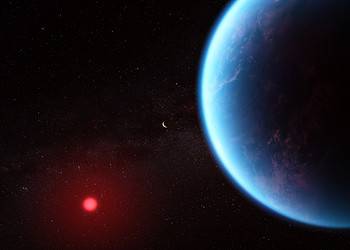
Astronomers have detected a small planet that is literally falling to pieces. The object, coined BD +05 4868 Ab, orbits a star in the constellation Pegasus approximately 140 light years from Earth. Each 30.5 hour lap strips away surface rock, sending a plume of dust nine million kilometers long—roughly equal to 23 trips from Earth to the Moon—streaming behind and, to a lesser extent, ahead of the planet.
The discovery, led by researchers at the Massachusetts Institute of Technology (MIT), appearing in The Astrophysical Journal Letters, adds only the fourth known example of a “disintegrating” planet. The discovery is approximately the size of Mercury and 20 times closer to its star than Mercury is to the Sun.
A Comet-like Planet
At such close proximity to its star, the planet is likely covered in magma boiling off into space. As the roasting planet whizzes around its star, it is shedding an enormous amount of surface minerals and effectively evaporating away, leaving a debris tail behind it.
“The extent of the tail is gargantuan, stretching up to 9 million kilometers long, or roughly half of the planet’s entire orbit,” says Marc Hon, a postdoc in MIT’s Kavli Institute for Astrophysics and Space Research.
The find began with data from NASA’s Transiting Exoplanet Survey Satellite (TESS), which patrols the sky for small dips in stellar brightness caused when planets pass in front of—or transit—their host stars. Most transits look like neat, symmetrical blinks. BD +05 4868 Ab’s signal, however, fluctuated in depth every orbit. This evidence led the astronomers to believe the planet was rocky and that the tail consisted of the planet essentially melting away.
The scientists discovered the planet is disintegrating dramatically, shedding an amount of material equivalent to one Mount Everest (roughly a trillion kilograms of rock) each time it orbits its star. At this pace, given its small mass, the researchers expect that the planet may completely disintegrate in about one to two million years.
“We got lucky with catching it exactly when it’s really going away,” said Avi Shporer, a collaborator on the discovery at the TESS Science Office. “It’s like on its last breath.”
Hon’s group is combing the TESS archive for similar oddities. Disintegrating planets are rare, and their signals can be overlooked because the dust makes each transit look different from the last. Automated software often flags such patterns as noise.
“Now that we know what to look for, we expect to find more,” Shporer said. “Each one will teach us about extreme environments and help map the life cycles of rocky worlds.”
For BD +05 4868 Ab, the clock is running. Every orbit leaves less planet and a broader cloud of glittering debris—a cautionary tale about the perils of living too close to the neighborhood star. Yet for these scientists eager to understand planetary interiors, this doomed world is offering its secrets via its grainy tail.
The researchers will also look through TESS data for signs of other disintegrating worlds.
“Sometimes with the food comes the appetite, and we are now trying to initiate the search for exactly these kinds of objects,” Shporer said. “These are weird objects, and the shape of the signal changes over time, which is something that’s difficult for us to find. But it’s something we’re actively working on.”






